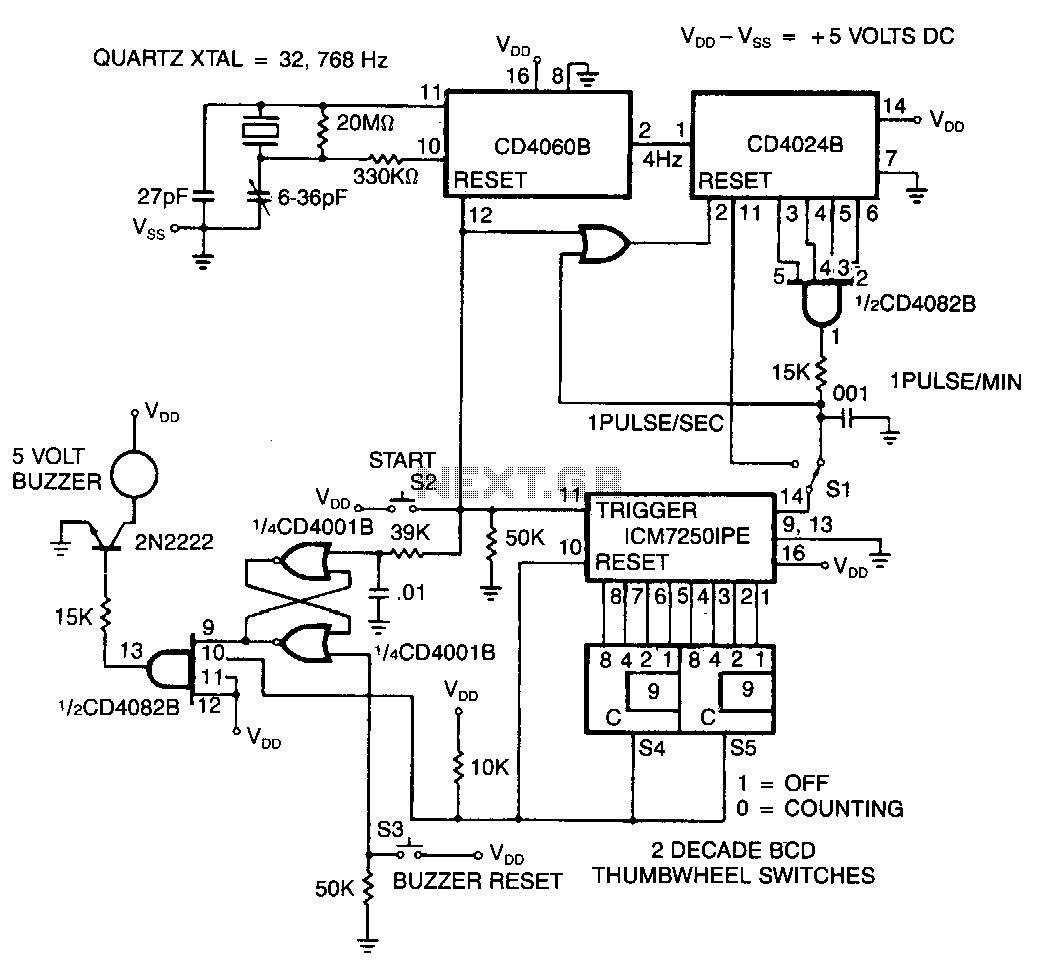
Cmos-precision-programmable-laboratory-timer

The time base is initially selected with switch S1 set for either seconds or minutes. Subsequently, values from 0 to 99 are chosen using the two thumbwheel switches S4 and S5. Finally, pressing switch S2 starts the timer. At the same time, the quartz crystal-controlled divider circuits are reset, the ICM7250 is triggered, and counting begins. The ICM7250 continues counting until it reaches the preprogrammed value, at which point the value is reset, pin 10 of the CD4082B is enabled, and the buzzer is activated. Pressing switch S3 deactivates the buzzer.
The timer circuit employs a microcontroller or timer IC, specifically the ICM7250, which is a versatile timing device capable of precise time measurement. The operational sequence begins with the selection of the time base, which determines the unit of measurement—seconds or minutes—using switch S1. The user can then set the desired countdown value between 0 and 99 via thumbwheel switches S4 and S5, which provide an intuitive interface for value entry.
Once the desired time is set, pressing switch S2 initiates the countdown process. This action triggers the ICM7250 to start counting from the selected value, while simultaneously resetting the quartz crystal-controlled divider circuits. This reset ensures that any previous counting states do not interfere with the new timing operation, maintaining accuracy.
The ICM7250 is designed to count pulses generated by the quartz crystal oscillator, which provides a stable frequency reference. As the ICM7250 counts down, it monitors its internal register against the preprogrammed value. Upon reaching zero, the timer resets its count and activates pin 10 of the CD4082B, a dual 4-input NAND gate. This pin activation triggers the buzzer, providing an auditory signal to indicate that the countdown has completed.
To silence the buzzer, the user can press switch S3, which interrupts the signal sent to the buzzer, effectively turning it off. This design ensures user control over the timer and its output, allowing for flexible operation in various applications. Overall, the circuit combines simple user inputs with precise timing capabilities, making it suitable for a range of timing applications.The time base is first selected with Sl set for seconds or minutes, then units 0-99 are selected on the two thumbwheel switches S4 and S5. Finally, switch S2 is depressed to start the timer. Simultaneously, the quartz crystal-controlled divider circuits are reset, the ICM7250 is triggered and counting begins.
The ICM7250 counts until the preprogrammed value is reached, then, the value is reset, pin 10 of the CD4082B is enabled, and the buzzer is turned on. Pressing S3 turns the buzzer off.
The timer circuit employs a microcontroller or timer IC, specifically the ICM7250, which is a versatile timing device capable of precise time measurement. The operational sequence begins with the selection of the time base, which determines the unit of measurement—seconds or minutes—using switch S1. The user can then set the desired countdown value between 0 and 99 via thumbwheel switches S4 and S5, which provide an intuitive interface for value entry.
Once the desired time is set, pressing switch S2 initiates the countdown process. This action triggers the ICM7250 to start counting from the selected value, while simultaneously resetting the quartz crystal-controlled divider circuits. This reset ensures that any previous counting states do not interfere with the new timing operation, maintaining accuracy.
The ICM7250 is designed to count pulses generated by the quartz crystal oscillator, which provides a stable frequency reference. As the ICM7250 counts down, it monitors its internal register against the preprogrammed value. Upon reaching zero, the timer resets its count and activates pin 10 of the CD4082B, a dual 4-input NAND gate. This pin activation triggers the buzzer, providing an auditory signal to indicate that the countdown has completed.
To silence the buzzer, the user can press switch S3, which interrupts the signal sent to the buzzer, effectively turning it off. This design ensures user control over the timer and its output, allowing for flexible operation in various applications. Overall, the circuit combines simple user inputs with precise timing capabilities, making it suitable for a range of timing applications.The time base is first selected with Sl set for seconds or minutes, then units 0-99 are selected on the two thumbwheel switches S4 and S5. Finally, switch S2 is depressed to start the timer. Simultaneously, the quartz crystal-controlled divider circuits are reset, the ICM7250 is triggered and counting begins.
The ICM7250 counts until the preprogrammed value is reached, then, the value is reset, pin 10 of the CD4082B is enabled, and the buzzer is turned on. Pressing S3 turns the buzzer off.